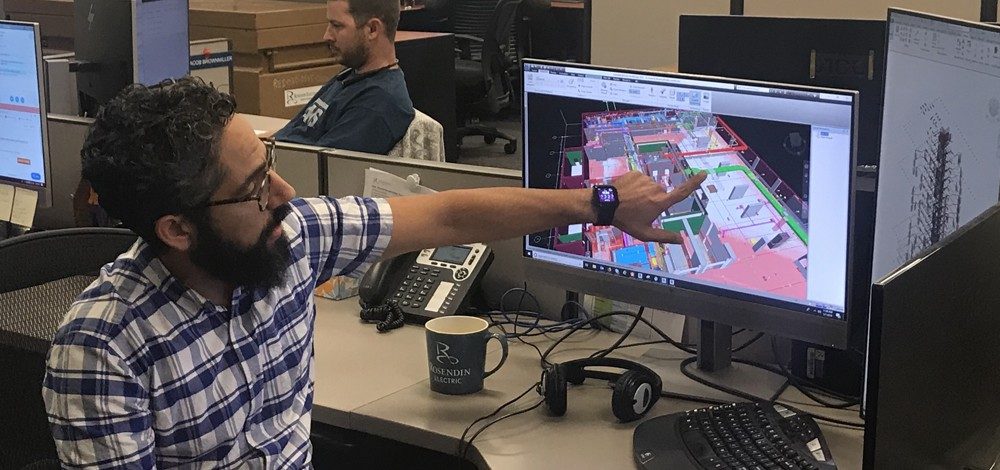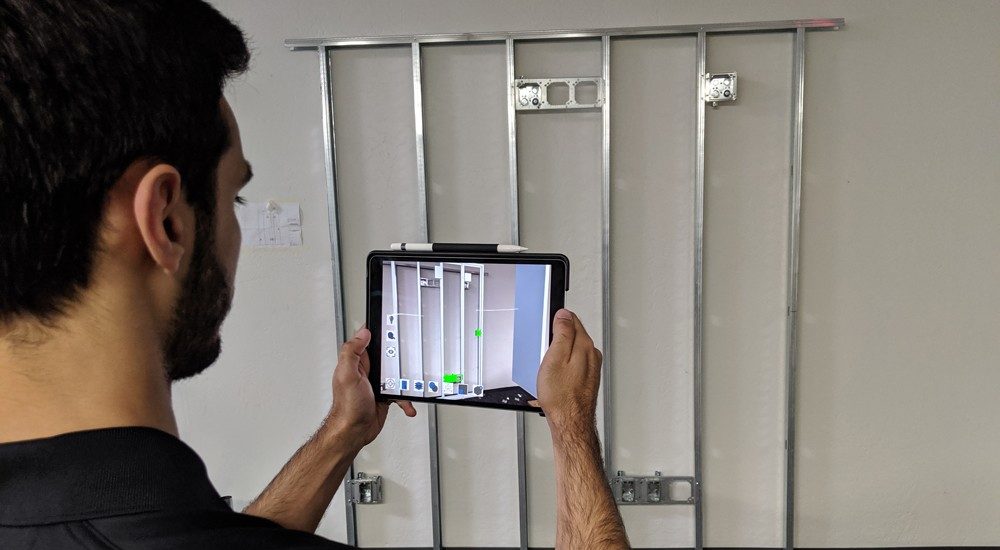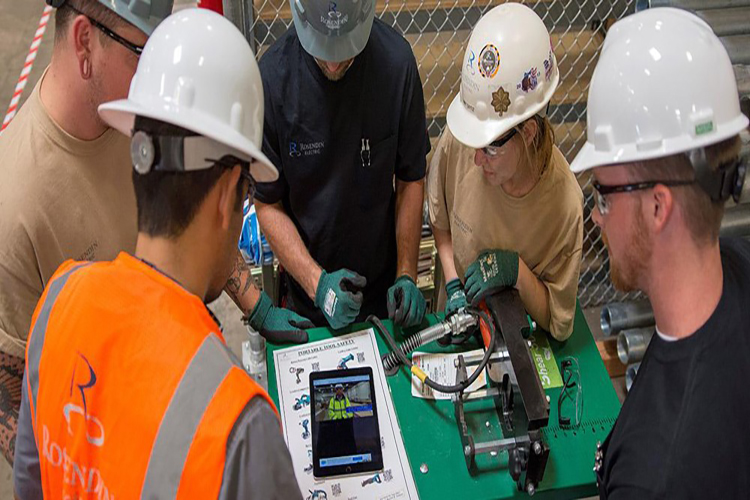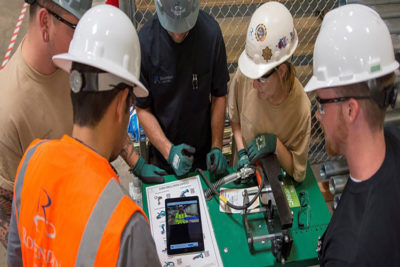Rosendin employees review plans on a tablet (Building Forward)
In the face of a skilled labor shortage with no end in sight, the construction industry is facing a paradigm shift. To be successful, firms must be innovative, embracing solutions and tools that improve efficiency and boost productivity. In short, every construction company has to become a technology company. Being more technologically open allows companies, managers, and staff to constantly meet their customers’ needs while improving internal results for the continuous improvement needed to stay competitive.
Innovation is one of the core values at Rosendin Electric, one of the largest electrical contractors in the United States, and one of the main reasons for the continued success of our firm. Rather than simply planning for or employing some of the latest technologies, Rosendin is helping to shape the future of the industry by developing technologies through in-house developments and strategic partnerships. Over the past decade, the Building Information Modeling department has been the cornerstone of this new dynamic.
Building information modeling, commonly referred to as BIM, is an operations tool through which an information-rich, 3D, digital representation of a project is created before the physical project is built. BIM represents an integrated system and repository of information, hosting data related to estimating, preconstruction, design, construction, quality control, and even facility management to provide a single source of information throughout the lifecycle of the project. Since BIM’s introduction over 15 years ago, it has become the new gold standard for designing and executing complex projects while providing consistency and traceability of all information hosted within.

A Rosendin employee examines BIM plans (Building Forward)
Building a BIM department
At Rosendin, the BIM team has grown from a staff of six in 2009 to more than 200 across the nation today. Rosendin’s BIM department is one of the largest in the United States, employing experts in construction, modeling, prefabrication, software engineering, extended-reality visualization, data science, and other advanced technologies.
Rosendin is committed not only to the adoption of available software suites but also to helping introduce new technologies whenever needed. Experts in Rosendin’s BIM department are continuously investigating emerging technologies, developing solutions, preparing training and information for other departments and divisions, and collecting data for performance analysis and continuous learning. One such endeavor is using information-rich augmented reality (AR) to enhance model access to site workers.
BIM has been used extensively in the office, and its benefits are well documented. However, usage on-site has always been a challenge, one of the biggest difficulties being the ability to visualize the model at full scale—to enable work planning, enhance spatial understanding of components, and enhance quality control and assurance processes. Traditionally, it has been cumbersome to bring full-size workstations to the jobsite, especially when conditions are quickly and unpredictably changing. Moreover, on-screen visualization is not optimal since it relies heavily on the viewer’s spatial abilities to understand the model in context. The BIM team set out to solve this problem by leveraging recent advancements in AR.

A Rosendin employee uses augmented reality (Building Forward)
An AR app that continues to evolve
Augmented reality is a technology that overlays virtual 3D models around a user. The technology relies on a reality-capture component, such as a camera, infrared sensors, or lasers, and a display, such as a screen or see-through projectors. The Rosendin BIM team created a dedicated application that runs on an iPad called SheetViewer. The SheetViewer application fully integrates with model and project data to show full-scale 3D models appropriately placed for the user’s view. Users can walk around an area with the iPad and visualize the model as it is intended to be built, comparing it to existing conditions and ongoing construction.
Over the past 12 months, SheetViewer has been used for QA/QC and work-planning processes on multiple Rosendin projects across the nation. In one year, we have seen significantly reduced layout time and improved quality and accuracy, along with reduction in labor costs, all while supporting field crews. While in use, the application continuously collects usage information and user feedback. The benefits of the data collection are two-fold from a development and analytics standpoint.
The usage data helps developers understand what application tools team members are utilizing the most and whether new tools are easily discoverable. The data also helps the developers monitor application crashes and misbehavior. By tracking this information, the BIM team can focus its efforts on continuous enhancements and better performance of the application. New tools can also be developed based on the most commonly used features to maximize the application’s effectiveness.
Targeted questionnaires and usage monitoring allow the analytics team in the BIM department to accurately quantify the benefits of using the application under different use cases. For instance, at Rosendin, we have been able to increase our volume of clash resolution in workflow by as much as 300%, which ultimately translates to lower costs. More importantly, output has increased within the same time frame. The team can set value goals based on observed performance, learn usage patterns, and deploy company-wide best practices to ensure consistency of anticipated results.
As it continues to grow, Rosendin’s BIM department is ensuring that the company maintains its technology leadership position within the industry. SheetViewer represents only one of the many efforts undertaken by Rosendin. The department is currently enhancing products and processes related to laser scanning, site layout, augmented and virtual reality, automated modeling and prefabrication, and other innovative technologies.
For Rosendin, becoming a technology company means investing the resources necessary to achieve a level of sophistication about these products that a traditional construction company couldn’t offer. At a time of rapid technological change, construction industry firms must find a way to support internal innovation—without being bogged down by chasing every new shiny object—or risk being left behind.
https://www.buildingforward.com/technology/why-construction-companies-must-become-technology-companies_o?bwts=1571694694


